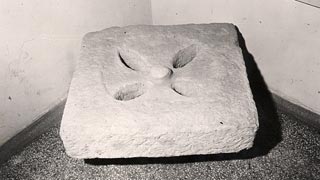Roman and medieval sewer systems
The history of sewerage in Vienna can be traced back to the Roman military camp of Vindobona, which was situated on the western bank of what is today the Danube Canal. To the northwest, the fort was bounded by the Tiefer Graben, a deep ditch that is now a street, through which the Ottakringerbach brook flowed until the Middle Ages. The Ottakringerbach divided the camp into two drainage areas.
Vindobona’s at the time state-of-the-art sewer system was built by the 13th Legion in 100 AD and later maintained and extended by the 14th and 10th Legions.
Roman sewer construction
The sewer bottom was usually made of roof tiles that were placed upside down (with the two side ridges facing upwards). Sometimes, a "concrete" of sorts was used. The sewers, which were usually square or rectangular, were covered with stone slabs five to fifteen centimetres thick.
For smaller sewers, clay pipes with tapered ends and a diameter of approximately 20 centimetres were manufactured. The individual pieces of pipe could be fitted into each other, creating a sewer line. Rainwater runoff was channelled into the sewers via stone grates. These covers were square stone slabs approximately ten centimetres thick that were decorated with oblong openings arranged in the shape of a star.
Decline in the Middle Ages
With the beginning of the migration period in the late 4th century, the first era of Vienna’s sewers came to an end. The high Roman standards of hygiene fell into oblivion. Medieval Vienna was a typical European city in terms of sanitation. Waste, both from households and crafts, was thrown into the streets or the nearest stream. Only when the city was flooded would the foul-smelling refuse be swept into the nearby Danube. This resulted in frequent epidemics.
Medieval sewers
The first documented reference to Medieval sewerage was found in the "Thonethaus" at Brandstätte 2, which was renovated in 1882. It refers to an early rudimentary form of sewer, a stone conduit called "Mörung" or "Moric". City accounts from 1445 also document the existence of larger conduits of this type, which had the purpose of draining sewage away from the proximity of residential areas as quickly as possible.
City of Vienna | Vienna Waste Water Management
Contact form

